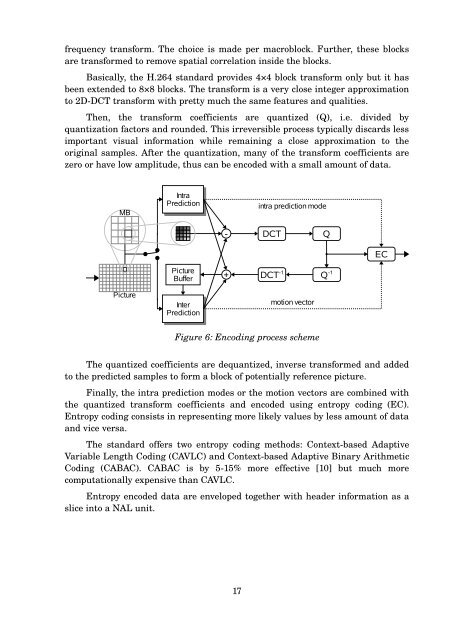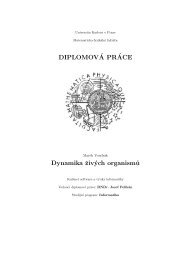MASTER THESIS Video Watermarking - Computer Graphics Group ...
MASTER THESIS Video Watermarking - Computer Graphics Group ...
MASTER THESIS Video Watermarking - Computer Graphics Group ...
Create successful ePaper yourself
Turn your PDF publications into a flip-book with our unique Google optimized e-Paper software.
frequency transform. The choice is made per macroblock. Further, these blocks<br />
are transformed to remove spatial correlation inside the blocks.<br />
Basically, the H.264 standard provides 4×4 block transform only but it has<br />
been extended to 8×8 blocks. The transform is a very close integer approximation<br />
to 2D-DCT transform with pretty much the same features and qualities.<br />
Then, the transform coefficients are quantized (Q), i.e. divided by<br />
quantization factors and rounded. This irreversible process typically discards less<br />
important visual information while remaining a close approximation to the<br />
original samples. After the quantization, many of the transform coefficients are<br />
zero or have low amplitude, thus can be encoded with a small amount of data.<br />
<br />
<br />
<br />
<br />
<br />
<br />
<br />
<br />
<br />
<br />
Figure 6: Encoding process scheme<br />
The quantized coefficients are dequantized, inverse transformed and added<br />
to the predicted samples to form a block of potentially reference picture.<br />
Finally, the intra prediction modes or the motion vectors are combined with<br />
the quantized transform coefficients and encoded using entropy coding (EC).<br />
Entropy coding consists in representing more likely values by less amount of data<br />
and vice versa.<br />
The standard offers two entropy coding methods: Context-based Adaptive<br />
Variable Length Coding (CAVLC) and Context-based Adaptive Binary Arithmetic<br />
Coding (CABAC). CABAC is by 5-15% more effective [10] but much more<br />
computationally expensive than CAVLC.<br />
Entropy encoded data are enveloped together with header information as a<br />
slice into a NAL unit.<br />
17
















